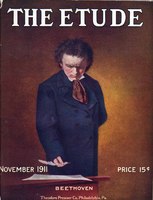BY H. C. HAMILTON.
It is not uncommon for some musicians to make comparisons between the pipe-organ and orchestra, chiefly on account of the organ’s wealth of tone color. But while the organist has at his disposal stops which are almost identical with, or at least strongly resemble, the principal orchestral instruments, yet, taken as a whole, the organ and orchestra are vastly different. The organ, if it be a good one, conveys to the hearer the sense of majesty and power, while the orchestra conveys the idea more of constant change, amounting at times to an almost feverish restlessness. Each fill their appointed place in the musical world, but the best results are lost when either one has to do duty for the other. That there do exist some good transcriptions for organ no one can deny, but the better class of organists prefer usually to draw from legitimate organ music, written for organ only.
Now, it might appear strange that the orchestra and organ are so dissimilar in some ways, while they each possess almost identical varieties of tone. One would naturally suppose with a fine organ, equipped with viol, flute, piccolo, oboe, clarinet, horn, trumpet, trombone, etc., that here is an orchestra all under the control of one performer. But these stops are not the mainstay of the organ, and herein lies the radical difference. The stops which are the foundation tone of the organ are not imitative stops at all, but rather those which give power and grandeur. The diapasons and others cannot be done without, many of the first-mentioned can. The orchestra depends mostly on its strings, as note the preponderance of violins as compared with either its wood-wind or brass. How is an organist to obtain that indescribable effect such as when the strings of an orchestra are playing alone? And how is an orchestra to have that effect—indescribable, too— that we hear when all the foundation stops—pedal and manual—of a fine organ burst on the ear? The magnificent tone of the pedal stops, with which we always associate the organ, is something not heard in the orchestra, notwithstanding the double-bass and brass tuba.
It will perhaps now be a little clearer why an orchestra selection sounds one way, and the same selection as an organ transcription has a totally different effect. When one depends on a vast concourse of strings for its body tone, and the other on the full round tone of open pipes, it is easy to see that while matters exist as they are, the two things must ever remain different.
THE STRING BASS.
When one hears an oratorio chorus with orchestra accompaniment, and again hears the same thing with an organ for support, many surprising differences will manifest themselves. Any organist who has played a selection such as the Pastoral Symphony, from Handel’s Messiah, will understand the difficulty of making the organ sound like an orchestra. Of course he will use the viol stop, and probably dulciana and aeoline, with pedal bourdon for bass. But will the effect be like that of twenty or thirty violins playing pianissimo with that long sustained C as the ground note almost inaudible on the deep bass string? No. What we usually hear is the hollow booming note of the sixteen-foot bourdon (grand though it is), which is far from reproducing the effect of double basses played softly. Then again, one or two string stops can never have that subtle sound of many muted violins.
THE ART OF CHOOSING THE RIGHT STOPS.
I once heard an organist endeavor to improve matters. He used the sixteen-foot bourdon, but probably thought that the long continued sound would be too much for his hearers, so every little while he would lift his foot from the pedals and play a few notes without any bass. Needless to say, the performance left much to be desired.
The famous organist, Best, when accompanying an oratorio, used the violin stop in the pedal, in lieu of the customary bourdon, thereby getting more of the orchestral effect.
But is it not better that organ and orchestra have their individualities? How perfect the ensemble of tone when a large chorus has the support of both! The organ can, from its very nature, supply that which is most needed in the portions where sublimity and power are required. The orchestra, because of its less ponderous tone, and the greater delicacy of its strings, can supply finer shading. The wood-winds and brass have also a more immediate and striking effect than the organ stops of the same name.



